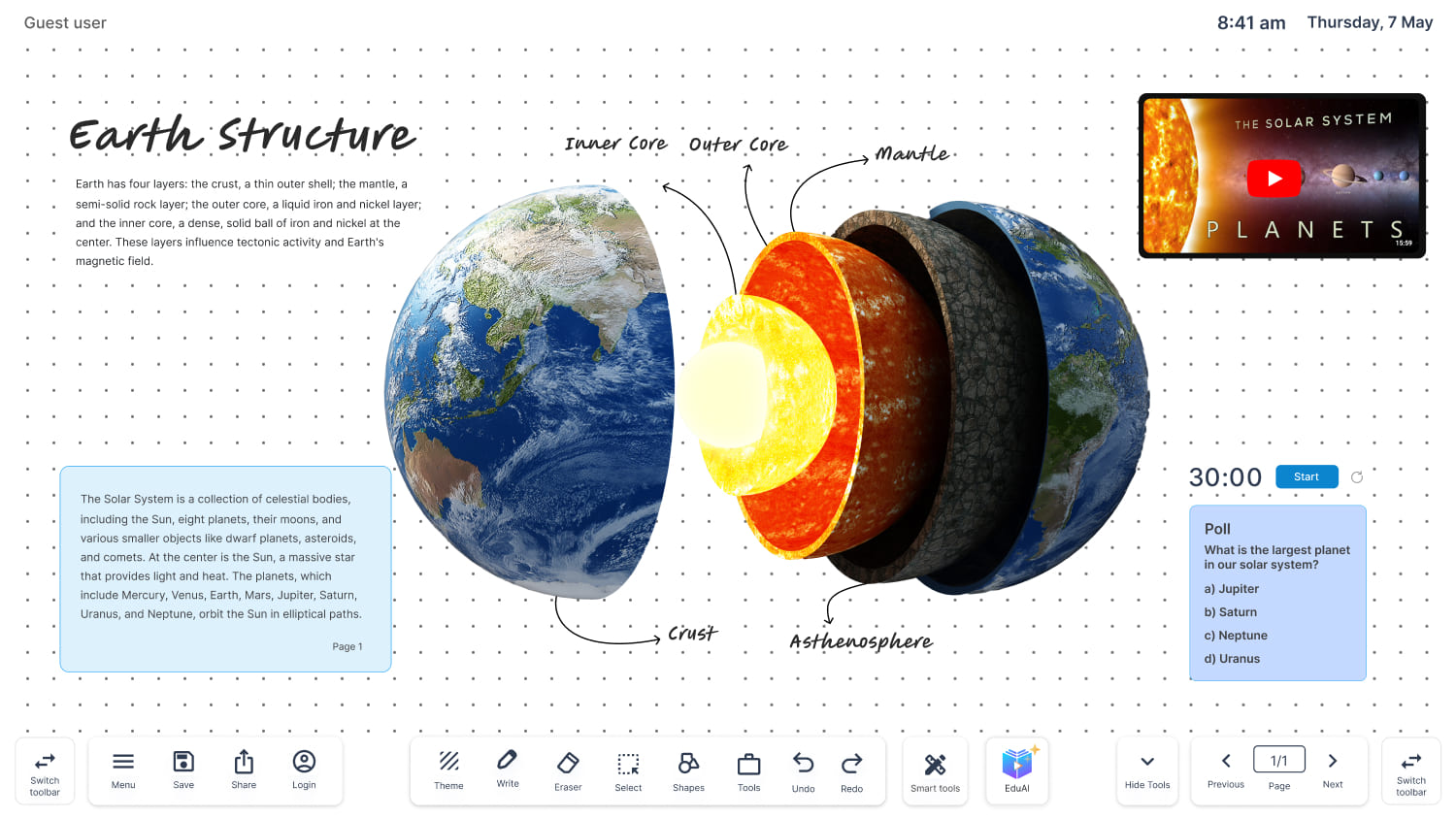In an era where education is rapidly evolving, the balance between traditional teaching methods and modern digital tools has become more critical than ever. The transition from chalkboards to smart technologies represents not just a shift in tools but a transformation in the way knowledge is shared and absorbed. At the heart of this educational revolution lies an invaluable asset: interactive whiteboards.
Interactive whiteboards have emerged as the cornerstone of blended learning, seamlessly integrating the tried-and-true practices of traditional education with the boundless opportunities of digital innovation. Whether it’s in a bustling elementary school classroom or a quiet college lecture hall, the interactive whiteboard has redefined the dynamics of teaching and learning. Let’s delve into how these technological marvels are bridging the gap between the past and the future of education.
Reviving the Traditional Classroom with Modern Tools
For centuries, the blackboard and its successor, the whiteboard, have been the mainstays of classrooms worldwide. These tools allowed teachers to visually explain concepts, engage students, and create a shared space for collaborative learning. However, they had their limitations. Static and one-dimensional, they couldn’t keep up with the dynamic needs of 21st-century learners.
Enter the interactive whiteboard, a tool that retains the simplicity of traditional boards while adding layers of interactivity, adaptability, and multimedia integration. Teachers can now:
- Annotate digital content directly on the board.
- Incorporate videos, animations, and simulations into their lessons.
- Access a wealth of online resources instantly.
- Save and share class notes for later use.
By combining the tactile familiarity of writing on a board with the power of digital technology, interactive whiteboards empower educators to deliver lessons that are as engaging as they are effective.
Transforming Passive Learning into Active Engagement
One of the most significant advantages of interactive whiteboards is their ability to turn passive learners into active participants. In traditional classrooms, students often acted as mere observers, jotting down notes while the teacher lectured. With interactive whiteboards, every lesson becomes a two-way street.
Imagine a biology class where students come up to the board to label parts of a cell using drag-and-drop features. Or a math lesson where equations are solved collaboratively, with students and teachers working together to find solutions. Interactive whiteboards make learning tactile and participatory, encouraging students to:
- Ask questions and test ideas in real-time.
- Collaborate with peers on group activities.
- Gain hands-on experience with interactive exercises.
By fostering collaboration and critical thinking, these boards help students build skills that extend far beyond the classroom.
Bridging the Digital Divide
In today’s tech-savvy world, the digital divide—the gap between those with access to technology and those without—remains a pressing concern. Schools play a vital role in addressing this issue by equipping students with the tools and skills needed to thrive in a digital society.
Interactive whiteboards serve as a powerful equalizer, ensuring that students from diverse backgrounds gain exposure to cutting-edge technology. They provide a gateway to:
- Online learning platforms and virtual field trips.
- Multimedia presentations and interactive assessments.
- Advanced tools like coding applications and STEM resources.
Moreover, interactive whiteboards are intuitive and easy to use, making them accessible to educators and students with varying levels of technical proficiency. By incorporating these tools into classrooms, schools can ensure that no student is left behind in the race toward digital literacy.
Catering to Diverse Learning Styles
Every student learns differently. While some thrive on visual aids, others absorb information better through hands-on activities or auditory inputs. Traditional teaching methods often struggled to address these diverse needs, but interactive whiteboards rise to the challenge.
With their multimedia capabilities, interactive whiteboards cater to:
- Visual learners: Use images, charts, and videos to illustrate concepts.
- Auditory learners: Integrate audio clips, discussions, and podcasts into lessons.
- Kinesthetic learners: Encourage physical interaction through touch-based activities.
This adaptability ensures that no matter how a student learns, they can engage with the material in a way that resonates with them. As a result, classrooms become more inclusive, and learning outcomes improve significantly.
Preparing Students for a Digital Future
Incorporating technology into education isn’t just about making lessons more engaging; it’s about preparing students for a world where digital skills are paramount. Interactive whiteboards play a pivotal role in this preparation by:
- Introducing students to collaborative tools and software.
- Teaching them how to navigate digital interfaces confidently.
- Encouraging problem-solving through interactive applications.
For instance, students working on a geography project might use the board to explore maps, analyze data, and present their findings to the class. These experiences mirror the collaborative, tech-driven environments they will encounter in higher education and the workforce.
Emotional Connection: Making Learning Fun Again
Beyond the intellectual benefits, interactive whiteboards inject an element of fun and creativity into learning. Lessons come alive with vivid visuals, engaging activities, and interactive challenges that spark curiosity and enthusiasm. When students enjoy what they’re learning, they are more likely to stay motivated and retain information.
Teachers, too, benefit from the excitement that interactive whiteboards bring to their classrooms. By streamlining lesson planning and offering diverse teaching tools, these boards reduce stress and reignite educators’ passion for teaching.
Overcoming Challenges and Ensuring Effective Implementation
While the benefits of interactive whiteboards are clear, their successful implementation requires careful planning. Schools must invest in training programs to ensure that teachers can maximize the potential of these tools. Additionally, ongoing technical support and regular software updates are essential to keep the boards running smoothly.
Despite these challenges, the investment in interactive whiteboards pays dividends in the form of improved student engagement, enhanced learning outcomes, and a future-ready education system.
A Vision for the Future
As education continues to evolve, the role of interactive whiteboards will only grow more significant. They are not just tools; they are bridges that connect the rich traditions of the past with the exciting possibilities of the future. By embracing this technology, schools can create learning environments that are inclusive, innovative, and inspiring.
Whether you’re an educator looking to modernize your classroom or a parent seeking the best for your child’s education, the message is clear: the interactive whiteboard is a game-changer. It’s not just about keeping up with the times; it’s about shaping the future of learning.
In the words of Nelson Mandela, “Education is the most powerful weapon which you can use to change the world.” And with interactive whiteboards, we’re equipping today’s learners with the tools they need to become tomorrow’s leaders.

